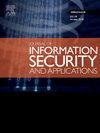A robust blind watermarking scheme for color digital images based on GJO and the maximal connected domain
IF 3.7
2区 计算机科学
Q2 COMPUTER SCIENCE, INFORMATION SYSTEMS
Journal of Information Security and Applications
Pub Date : 2025-10-03
DOI:10.1016/j.jisa.2025.104249
引用次数: 0
Abstract
The problem of image piracy is becoming more and more severe in today’s society contemporary society. To resolve this problem of protecting the copyright of color images, a robust color image blind watermarking scheme based on the golden jackal optimization algorithm (GJO) and the maximal connected domain is proposed. GJO is adopted to select the threshold of the maximal connected domain and the quantization step of watermark embedding, and the maximal connected domain of the main image is selected as the embedding region based on a specific threshold. Then, the embedding area is divided into RGB three-layer channels. Each layer of channels is divided into non-overlapping matrix blocks with size of 4×4. Two watermark bits are embedded in each block. Specifically, two watermark bits are quantized and embedded into the first two elements in the first row of the matrix after the Householder transform, and double overflow treatment is applied to the embedded values of the watermark to improve its robustness. The experimental performances are shown as follows: 1) the average values of PSNR and SSIM are above 40 dB and 0.96, respectively; 2) the values of NC are above 0.95 under different attacks; 3) the theoretical maximum capacity for watermark information is four times the actual capacity; 4) The time complexity of embedding a watermark bit is O(n2). The experimental results indicate that the scheme proposed exhibits good performance in robustness, invisibility, time complexity, watermark embedding capacity, and other aspects.
一种基于GJO和最大连通域的彩色图像鲁棒盲水印方案
在当今社会,图像盗版问题日益严重。为了解决彩色图像的版权保护问题,提出了一种基于金豺优化算法(GJO)和最大连通域的鲁棒彩色图像盲水印方案。采用GJO选择最大连通域的阈值和水印嵌入的量化步长,并根据特定阈值选择主图像的最大连通域作为嵌入区域。然后,将嵌入区域划分为RGB三层通道。每层通道被划分为大小为4×4的不重叠矩阵块。每个块中嵌入两个水印位。具体来说,在Householder变换后,将两个水印位量化并嵌入到矩阵第一行的前两个元素中,并对水印的嵌入值进行双溢出处理以提高其鲁棒性。实验结果表明:1)PSNR平均值在40 dB以上,SSIM平均值在0.96以上;2)不同攻击下NC值均在0.95以上;3)水印信息的理论最大容量是实际容量的4倍;4)水印位嵌入的时间复杂度为0 (n2)。实验结果表明,该方案在鲁棒性、不可见性、时间复杂度、水印嵌入能力等方面具有良好的性能。
本文章由计算机程序翻译,如有差异,请以英文原文为准。
求助全文
约1分钟内获得全文
求助全文
来源期刊

Journal of Information Security and Applications
Computer Science-Computer Networks and Communications
CiteScore
10.90
自引率
5.40%
发文量
206
审稿时长
56 days
期刊介绍:
Journal of Information Security and Applications (JISA) focuses on the original research and practice-driven applications with relevance to information security and applications. JISA provides a common linkage between a vibrant scientific and research community and industry professionals by offering a clear view on modern problems and challenges in information security, as well as identifying promising scientific and "best-practice" solutions. JISA issues offer a balance between original research work and innovative industrial approaches by internationally renowned information security experts and researchers.
 求助内容:
求助内容: 应助结果提醒方式:
应助结果提醒方式:


